Abstract
Material selection is a challenging process in which several parameters should be considered for green-certified projects. Hence, this study investigates the dynamics of sustainable material selection (SMS) across the project life cycle using system thinking. A dynamic model was developed based on the Leadership in Energy and Environmental Design where relevant environmental categories and credits were represented, and their dependency coefficients (DCs) were computed. This pinpointed the effect of SMS on the point-accrual pattern across project phases, showing that the high leverage points were demonstrated for the operation phase. The result showed that SMS extended beyond the efficient use of materials, which indicated a DC of 100% in the Materials and Resources category to affect other sustainable categories, i.e., the indoor environmental quality, energy efficiency, and sustainability of the project site comprised 68.8%, 57.6%, and 50% of DCs, respectively. Thus, optimal SMS could earn the project 48% of the total possible points, putting it in the ‘Certified’ level. Accordingly, the proposed model can be used to evaluate the level of certification as well as the building performance therein.
1. Introduction
The choice of sustainable building materials and their acquisition for a green/certified project are seen as crucial pillars in any green building process. This is a challenging process that necessitates the adoption of a comprehensive problem-solving approach to account for its many interrelated parameters. In this regard, it is noted that using the science of systems thinking (ST) to solve complex dynamic challenges and changeable interrelating characteristics of sustainable projects is considered a developing topic of study with much potential. Recent research has used the ST approach as an innovative way of simulating sustainable buildings from a life cycle perspective [1]. It is also used as a decision-making tool for building design and operation [2] and to study the impact of site selection on building performance [3,4]. This provided a comprehensive view of interrelated parameters and enabled interactions with building information modelling and other software tools in the building process [5,6]. Thus, this study offers a valuable empirical method for thinking about buildings as dynamic systems, emphasising the impact of material selection for green-certified projects through an ST approach. This is a compound challenge that discusses aspects related to the green building process as a whole, in addition to others concerning the green certification.
Green building rating systems (GBRSs) provide certified third-party declarations. They evaluate the projects’ environmental performance in accordance with predetermined criteria. This varies according to the relative importance weight of each criterion contributing to environmental stewardship. For the topic of the sustainability of materials and resources, some GBRSs offer a prescriptive set of guidelines, while others are based on performance evaluation [7,8]. The former is simpler for practitioners to apply because it is based on physical material attributes (area, weight, and volume) [9]. The latter is based on Life Cycle Assessment (LCA), which scrutinizes all inputs and outputs for a material or product. This describes how these systems have developed to meet the increasing demands of the real estate market. They also raise the bar for the minimal criteria mandated by building regulations and standards [10]. In this regard, the Leadership in Energy and Environmental Design (LEED) is an internationally recognised and broadly used building assessment system. It incorporates material selection among its core categories, i.e., Materials and Resources (MR) [11]. This is in addition to other categories: Location and Transportation (LT), Sustainable Sites (SS), Water Efficiency (WE), Energy and Atmosphere (EA), and Indoor Environmental Quality (IEQ). Previous LEED versions constituted a prescriptive set of criteria for material selection; nevertheless, its most recent update (LEED version 4.0) includes LCA with a greater emphasis on disclosure and optimization.
This is a challenging process that involves many interrelated parameters. On one hand, it is affected by site potentials in terms of the availability of green and certified materials and resources, as well as its life cycle impact [3,12]. On the other hand, it has an impact on the project’s energy efficiency as well as the quality of the indoor air [13,14]. Hence, this study investigates the direct and indirect relations of sustainable material selection (SMS) with other criteria and represents these dynamic interrelations using the science of ST. In this regard, it is noted that unsuitable material selection may result in a reduction in the building performance as a result of a lack of understanding of the system’s behaviour, structure, or interrelations [2,15].
Thus, this study poses the following questions to investigate this scientific argument: How can we comprehend and put together the different parameters associated with SMS? What kind of causal relationships exists between material selection and other sustainable categories? How can the selection of building materials affect the dynamics of the green building structure, behaviour, and interrelations? What are the high leverage points for material selection across different project phases?
2. Reviewing Literature for SMS
A comprehensive literature review was conducted using Boolean expressions for the following keywords: sustainable building materials, guidelines, measurement, verification, and certification. These were selected based on insights from previous studies discussing SMS in GBRSs [8,11,16]. The review method used the Web of Science and ScienceDirect databases, focusing on papers published in the last five years to obtain the latest findings on this research topic.
To acquire a comprehensive understanding when making choices related to material selection for green-certified projects, scholarly output concerning SMS for green-certified projects can be categorized into four interrelated scopes. Primarily, this includes a rating mechanism constituting prescriptive guidelines and measurement methods [8]. Other attributes are associated with the certification mechanism to comply with the required verification techniques and certification requirements [17]. Hence, optimizing these four-tiered processes across different project phases is the key to an insightful selection of materials. Nevertheless, the inherent synergies between issues linking material selection with other sustainable criteria are seldom explored, especially from an ST perspective.
2.1. Guidelines
There are several guidelines for SMS in various GBRSs that can work in tandem with other sustainable criteria. Designing with regard to material resilience and durability, as well as robustness, disassembly, and flexibility, is important to ensure materials’ extended life service.
In this regard, durability refers to how long a product will last before it needs replacement. Scientific studies are always trying to enhance materials’ durability, linking it to life cycle aspects and the project’s sustainability goals [18], noting that the durability of timber [19], as well as recycled concrete, has attracted researchers’ attention [20]. Additionally, resilience is an approach used to assess a system’s ability to modify and adapt continuously to withstand extreme conditions and still function properly. This considers shifting external forces and internal dynamics [21] and can be applied to an entire building level or individual materials and products. Examples of this include how well a building can achieve energy efficiency and still maintain thermal comfort under extreme weather conditions [22].
Disassembly is when a building element or product can be taken apart easily so that its parts can be reused or recycled at the end of its life cycle. A recent study has discussed the environmental benefit arising from the use of demountable steel–concrete composite floor systems [23]. Another scholar has pointed out that design for disassembly is an environmentally sustainable design approach that should be considered during the early decision-making process to account for the flow of materials across the building’s life [24]. Similarly, flexibility refers to how easily a design changes its shape or form in response to external forces such as heat or pressure [25,26]. An example of this is the use of some material properties, e.g., piezoelectric materials, that can produce electric energy upon application of mechanical stress. This can be used for flooring tiles, especially in densely populated buildings [27].
Guidelines for materials with high solar reflective index are recommended by many GBRSs and building standards [28]. Also, guidelines intended at promoting recycling initiatives both onsite and offsite extend materials’ service life. Onsite recycling is more sustainable because it saves costs on maintenance, landfill, energy use, and primary materials. Offsite recycling should consider the mass of the recycled product, the energy needed while recycling, and the distance to the recycling station. This is in addition to the energy used for transportation and the waste emitted therein [29].
Supporting the use of regional/local materials reduces the impact of transportation and raises awareness of local goods. This includes being close to areas used for extraction, harvesting, and manufacturing [30]. The benefits to the environment and local economy create win–win opportunities in this case. Nevertheless, this depends on the availability of local materials and their specifications for the desired use. Other guidelines include encouraging the use of natural or quickly renewable resources (such as cork, bamboo, natural rubber, wheat, and cotton). It also prioritises plants with quick harvest cycles when selecting raw materials [31]. This reduces the energy used to manufacture artificial materials and considers the efficiency of using land for more yield productivity.
The demand for virgin resources has decreased, and less waste is produced through the use of recycled materials that are salvaged, reconditioned, or repurposed. This reduces the effect of the extraction and processing phases and allows for the reuse of building elements and products [32]. Recycled materials may include pre-consumer content (waste from manufacturers) and post-consumer content (waste from consumers), with the latter offering a higher environmental benefit.
The health issues caused by interior construction materials and products are reduced by encouraging the use of low-emission materials [33]. For composite wood and agrifiber products, GBRSs establish limits for volatile organic chemicals and urea–formaldehyde. However, these ought to be compared to third-party certification for a longer list of manufacturing standards’ emission specifications [34,35].
Additionally, guidelines for sustainable management plans receive considerable attention from practitioners. An example of this is the construction waste management (CWM) plan, which is intended to separate and recycle mixed construction waste [36]. It is worth noting that the handling of hazardous materials onsite should be performed in accordance with environmental and health laws and standards [37].
2.2. Measurement
In research and academia, the selection of sustainable materials has been supported by various means, including simple ranking methods, multi-objective optimization, index-based methods, as well as cost–benefit analysis. The former is a method for multi-criteria decision-making based on the outranking model. It allows a choice of alternatives to be ranked in accordance with established decision preferences. In this regard, a recent study has developed an incremental elicitation approach to choose informative pairs of choices for material selection [38]. Multi-objective analysis has been used to integrate performance indicators, e.g., mechanical and environmental properties [39]. Another scholar has used the exchange constant chart to assist designers to select materials in multi-criteria situations [40]. Another interesting study has presented a methodology to evaluate optimum materials for engineering design using an integrated approach. The study has applied a model constituting seven material alternatives and six criteria for material selection. Criteria weights have been computed using the entropy method. Further, the ranking of alternatives has been computed using the technique for order performance by similarity to determine the ideal solution method [41]. Nevertheless, these methods do not provide a comprehensive understanding of the effect of material selection on building performance and certification level.
The measurement method for SMS in GBRSs follows a simpler approach which is more similar in practice. In this regard, the surface area measurement is used to compare the building’s overall preserved surfaces, e.g., the floors, facades, and internal divisions of a building. Additionally, it is used to provide insight into the use of indoor spaces, e.g., to compare the space set aside for recycling activities. Materials’ weight (or mass, interchangeably) is used as a unit of measurement for landfill-avoided building waste [9]. The volumetric unit is another commonly used way to quantify landfill-avoided building waste. The percentage of reused, recycled, renewable, and local materials utilised in the project is usually calculated in monetary terms as a percentage of the total material cost [42]. According to international regulations, the emission limits of materials are used to assess how building materials may impact users’ health during the construction and operation phases [34,43]. Hence, it is important to consider low-impact materials when evaluating and comparing options. The waste reduction model created by the Environmental Protection Agency may also help solid waste planners track and report the impact of utilising various waste management methods [44].
2.3. Verification
Depending on the purpose and reach of sustainable criteria, different verification tools and techniques are used. These can be applied to internal development, decision-making, and external communication.
The list may include using LCA to support decisions on material choice [45], building reuse, and waste management strategies for Construction and Demolition (C&D) [9]. This takes into account not only the physical characteristics of materials (e.g., weight, area, or volume) but also and especially their impact on the environment [46]. For a reliable account of the environmental loads, it is advisable to verify the accuracy of the material inventory databases [45,47,48].
Looking into trade-off relationships between material selection and energy efficiency is a necessity, noting the significant effect it has on building performance [30,49]. Hence, the use of commissioning, as well as the measurement and verification processes, is beneficial [50]. Further, looking at how building materials affect indoor air quality indicates that there are a number of health-related issues, both immediate and long term. These should be considered for an optimized material selection that does not result in sick building syndromes. A post-occupancy evaluation, along with ongoing monitoring and follow-up actions, can be used to look into issues related to indoor occupants’ comfort [49].
Additionally, developing management plans and follow-up measures that incorporate inventories can minimise the adverse environmental impact and guarantee regular inspection and maintenance procedures [51,52]. In this regard, scholars have developed a model for building design waste reduction strategies that aim to investigate the relationships between design variables and their impact on onsite waste reduction [53]. The model investigates causes and quantifies potential source reduction levels. Other studies have used the system dynamics model to assess the effects of management strategies on the reduction of C&D waste [54]. It has also been used to assess the economic performance of construction waste reduction strategies and measures [55]. The model includes seven causal loop and stock–flow diagrams, representing the contributing factors for the C&D waste reduction system [54]. Another model comprises three subsystems, covering waste generation and disposal, waste reduction, and economic performance assessment. The findings recommend combining different waste reduction strategies for better outcomes [55].
2.4. Certification
Continuous research is needed to determine the market availability and cost of green-certified materials [8,11]. This scrutinizes market opportunities for the supply and cost of locally produced, recycled, renewable, and reused materials as well as their functional specifications [56].
Additionally, some studies have analysed the role that green third-party product certifications play to facilitate corporate life cycle management and direct the supply chain towards sustainability. Hence, such programmes enable businesses to delegate the task of communicating, inspiring, enabling, and managing sustainability-related information and performance upstream [57]. Examples of this are the third-party certification for the sustainable management of resources, such as the American Tree Farm System, Sustainable Forestry Initiative, CarbonFix, and Forest Stewardship Council [58]. In this regard, a recent study has proposed an international instrument for knowledge development through the participatory and collaborative mapping of certified forests for sustainable management [59].
Other examples include using the International Standard Organisation (ISO) 14020 (2000) to provide useful and consistent information about a product’s environmental impact [60]. Type I environmental labels or ecolabels are multi-criteria-based, third-party-verified labels given to products that meet specific product environmental criteria based on life cycle considerations. Type II self-declared environmental claims are made by manufacturers and businesses without set criteria, benchmarks, or quality checks. Type III environmental declarations (e.g., EPD) are third-party-validated quantitative declarations. They also follow Product Category Rules, which are created especially for the product category under consideration. It should be mentioned that Type II environmental claims are the most common on the market but have the smallest connection to LCA studies, whereas Type III environmental declarations are the most trustworthy and closely tied to LCA studies according to ISO 14040 [61]. This is why it is included in many GBRSs, as well as in LEED version 4.0, as a verified third-party certification system.
3. Materials and Methods
The study investigates the tools, techniques, and practises for SMS suggested by the LEED system. It identifies material-dependent credits, categorizes them into the four defined scopes, and determines the parameters’ dependency coefficient (DC). Then, the study represents the causal relations of SMS with other sustainable criteria using the science of ST. This study also investigates the effect of SMS on the point-accrual patterns across varying project phases, which affect overall certification levels. The research steps are shown in Figure 1.
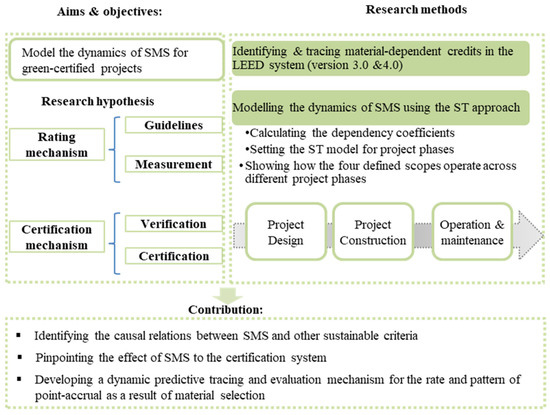
Figure 1.
The research plan, showing its aims, research methods, and contribution.
3.1. Determining MR-Dependent Credits
The study referred to LEED version 4.0 for Building Design and Construction. This included a content analysis method for credits’ intent, score weighting, and compliance paths. The full list of credits and their score weighting can be found at https://www.usgbc.org/leed-tools/scorecard (accessed on 13 June 2023). This step scrutinized a breakdown analysis of their role in the construction process, providing guidelines, measuring techniques, verification standards, as well as certification and market-related aspects. It also identified the criteria associated with SMS and pinpointed the interplay of points across various project phases.
Thus, MR-dependent credits were determined using the LEED project checklist and score weighting tool. It is noted that (n) indicates the number of points allocated for each sustainable criterion and reflects its relative weight. Noting that decisions related to material selection affect a project’s performance in many ways, positive dependence paths were signalled between different criteria. The selection process should focus on materials with minimal impact on the environment, hence reducing the impact on the building life cycle (n = 5). Building product disclosure and optimization should investigate environmental product declarations (n = 2), the sourcing of raw materials (n = 2), and material ingredients (n = 2). The storage and collection of recyclables should take place during building operation, and it should be followed by C&D waste management planning and execution (n = 2).
Causal relations were pinpointed for two credits in the SS category: Rainwater Management (n = 3) and Heat Island Reduction (n = 2). This is because the proper selection of materials with a high solar reflective index could help mitigate the heat island effect. It could also help control rainwater management by using perforated paving and similar eco-friendly solutions. For the EA category, two credits were identified: Optimize Energy Performance (n = 18) and Enhanced Refrigerant Management (n = 1). In this regard, the selection of materials could act as passive means for controlling solar heat gain in walls, floors, envelopes, glazing systems, as well as roof structures. Additionally, the type of refrigerants used for the mechanical ventilation system should follow international standards for cleaner building production and operation. Also, six credits were identified for the IEQ category: Low-Emitting Materials (n = 3), Construction Indoor Air Quality Management Plan (n = 1), Indoor Air Quality Assessment (n = 2), Thermal Comfort (n = 1), Daylight (n = 3), and Acoustic Performance (n = 1). This started with setting an efficient indoor air quality management plan during construction to ensure minimal effect on the surrounding environment. Design decisions should consider using low-emission materials to guarantee a better quality of indoor air. It could also help achieve thermal, visual, and acoustic comfort. This step showed the causal relations of SMS with other sustainable criteria, which acted as the basis for model development.
3.2. Calculating the Dependency Coefficients
Then, as a percentage of the total available points, the DC of credits and categories related to material selection were calculated. Relations were identified for 15 credits and 2 prerequisites distributed across different LEED categories. The study used the Full Accounting Association Strength method; hence, the total score weighting was accounted for when the conditions of causal relations were fulfilled. For example, the ‘Materials and Resources’ category, with a total of 13 available points, included the credit ‘Building Life-Cycle Impact Reduction’ of 5 points. Because the credit’s intent demonstrated a link to material selection, it was classified as a dependent parameter, and its DC was computed following Equation (1). In this case, 5/13% = 38.5%, and likewise for the remaining sustainable criteria. Thus, the DC was calculated for the SS, EA, IEQ, and MR categories as 50%, 57.6%, 68.8%, and 100%, respectively. In contrast, no related credits were identified for the LT and WE categories; hence, their DC was computed as zero.
DC = percentage of credit’s point weighting/total allocated points for its corresponding category
3.3. Modelling the Dynamics of Material Selection Using the ST Approach
An ST-based model was constructed using the VENSIM PLE 9.3.4.0 software application to examine and test the causal relations of SMS with other sustainable criteria. It was also used to determine the high leverage points of the system’s behaviour across different project phases. The model was used to investigate different scenarios of point accrual based on SMS. Figure 2 shows the causal relationships of the defined variables in the model. The main LEED categories were included in the model boundaries, whereas dependent credits were included as subsystems. The sum of the total points gained was characterised as ‘Stocks’. These operated as registers of acquiring points over time based on compliance with various credit requirements. For each category, the rate of point accrual was represented over time. Decisions, in turn, changed the rate of the flow (increase/decrease) of point accrual in the defined categories, changing stocks and closing the system.
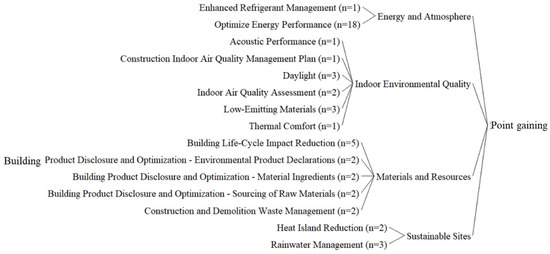
Figure 2.
Defining the causal relationships of defined variables.
Figure 3 depicts the model construction, showing the system boundary, subsystems, and interrelations. It also shows the four defined scopes, LEED categories, and their subsequent credits, as well as how they act across different project phases to obtain the total number of points, determining the LEED certification level as a result of SMS.
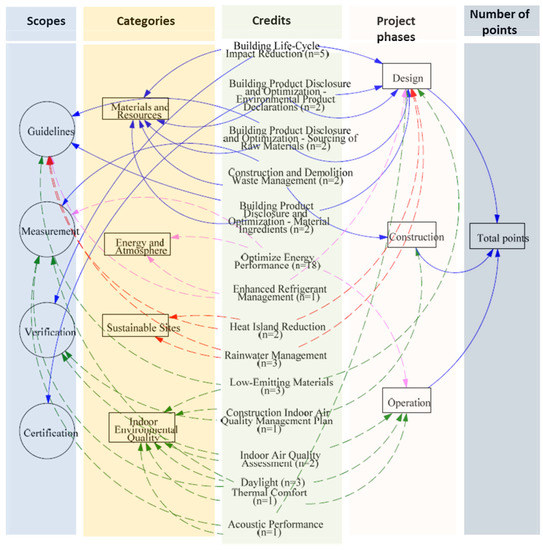
Figure 3.
Model construction.
4. Results
The results showed that not only did SMS affect the MR category, but it established casual relations with other sustainable categories as well. When these intrinsic relationships were examined, optimal SMS could gain the project 48 points out of 100, i.e., 48% of the total possible points, putting it in the ‘Certified’ certification level.
The interplay of point-accrual patterns for different scopes of SMS is represented across project phases using a Sankey diagram as shown in Figure 4. The credits were traced across a project’s life cycle to determine the long-term effect of material selection on building performance. Then, the high leverage points represented crucial decisions that affected the project’s life cycle, such as:
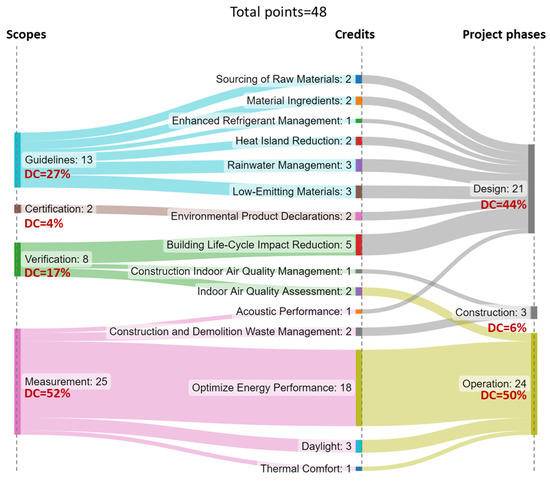
Figure 4.
A Sankey diagram to representing the interplay of point-accrual patterns for different scopes of SMS and across project phases.
- ▪
- Comparing different scopes: the scope of Measurement scored the greatest contribution for point accrual of 25/48 = 52%, followed by Guidelines, Verification, and Certification at 27%, 17%, and 4%, respectively;
- ▪
- Regarding sustainable categories, the MR category indicated the highest DC of 100%, followed by IEQ, EA, and SS at 68.8%, 57.6%, and 50%, respectively;
- ▪
- In terms of project phases, it was noted that the greatest contribution to the point-accrual pattern was preceded by the operation phase of 50%, followed by the design and construction phases, at 44% and 6%, respectively.
This shows that SMS varies across the four defined scopes. It necessitates more attention during the scopes of measurement and guidelines. Also, its effect is demonstrated across different project phases. Nevertheless, its impact is more pronounced during the operation and design stages.
5. Sensitivity Analysis
The project development timetable was hypothetically depicted in 12 months as shown in Figure 5. The model was checked for sensitivity and dimensional consistency in extreme settings. This was performed to resolve errors and gain a better understanding of interrelated variables to SMS. The influence on other sustainable categories was then demonstrated by comparing numerous case scenarios to the reference case (where all points were successfully gained). Hence, additional four simulation scenarios were performed for cases EA = 0, SS = 0, IEQ = 0 and MR = 0 and represented in Figure 6, Figure 7, Figure 8 and Figure 9. These scrutinized the worst-case of failure to gain points for the EA, SS, IEQ and MR, respectively. Comparing the four extreme case scenarios to the reference case showed that the maximum rate of point-accrual was recorded for the reference case, followed by cases SS = 0, IEQ = 0, MR = 0 and finally EA = 0. This indicates the importance of the EA category and that it is very challenging to gain points in the extreme case of not obtaining points under this category.

Figure 5.
Comparing the four extreme simulation scenarios.
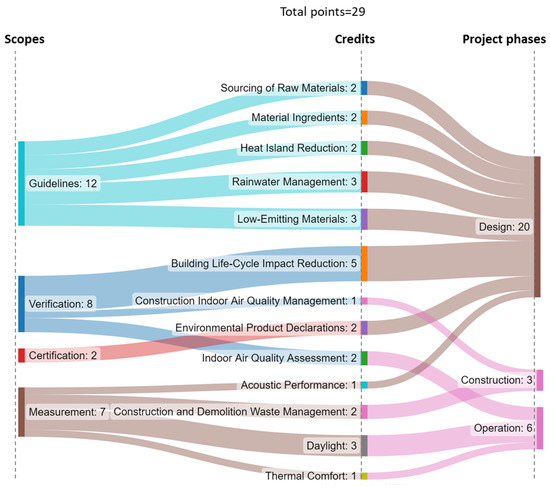
Figure 6.
Extreme case scenario EA = 0.
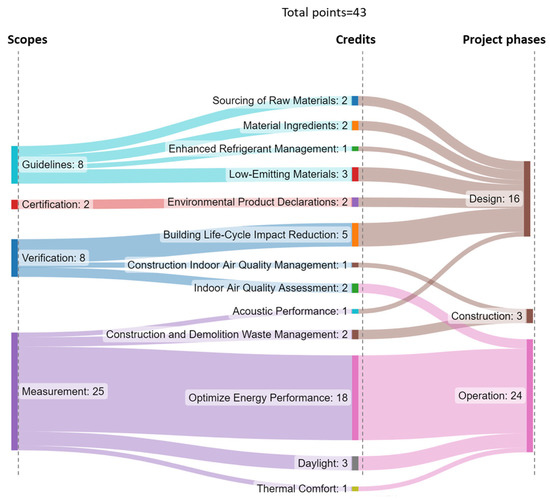
Figure 7.
Extreme case scenario SS = 0.
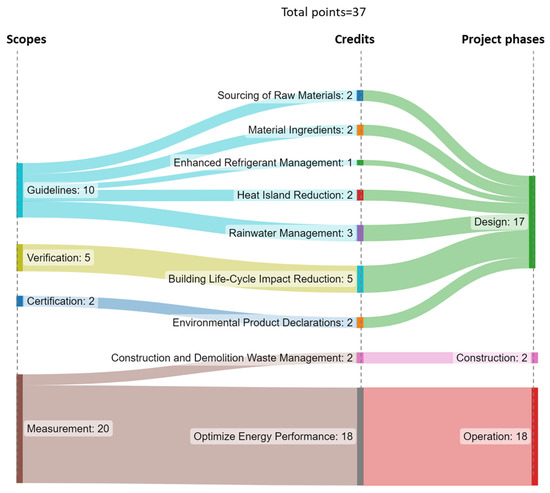
Figure 8.
Extreme case scenario IEQ = 0.
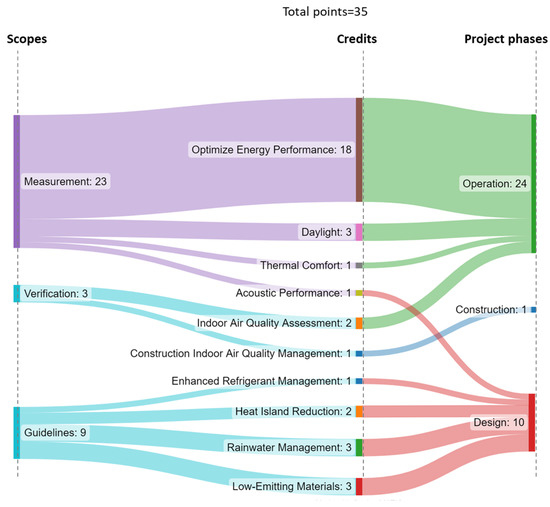
Figure 9.
Extreme case scenario MR = 0.
Scrutinizing the effect of the point-accrual pattern when EA = 0 showed more reliance on the scope of the guidelines, while more reliance was demonstrated for the measurement scope in cases of SS = 0, IEQ = 0, and MR = 0. This indicates that, in the former case, the project team should pay more attention to prescriptive guidelines, while, for the latter, less attention can be paid to the prescriptive approach and more to the performance one. Thus, the use of accurate measurement tools and techniques can enable the acquisition of points.
Analyzing the effect of the point-accrual pattern when EA = 0 showed that gaining points was possible during the design phase. Thus, the role played by the design team can determine whether the aspired project certification level is obtained. On the other hand, when MR = 0 or SS = 0, points were mainly gained during the operation stage. Thus, the simulation of building operation scenarios can be the best way to record points in these extreme cases. Finally, in the case of IEQ = 0, more attention should be paid to the design and operation stages. Thus, the design team should work on designing and testing the building performance to be able to optimize conflicting parameters.
This sensitivity analysis added further levels of reliability to the outcome results and further elucidated the role played by SMS in obtaining green building certification.
Comparing the four extreme case scenarios shows that it is more challenging to obtain points primarily when EA = 0, followed by when MR = 0, IEQ = 0, and, finally, when SS = 0, respectively. It also shows that more attention should be paid to the scope of guidelines in cases that fail to obtain points under the EA category; meanwhile, the measurement scope plays a major role when SS = 0, MR = 0, and IEQ = 0. The verification and certification scopes demonstrate a lower contribution to point accrual in this regard, but it is noted that, in cases that fail to obtain points for the EA or SS categories, the verification method should be implemented to guarantee optimum building performance. In sum, Figure 10a compares the point accrual patterns for the four defined scopes and Figure 10b illustrates them across different project phases.
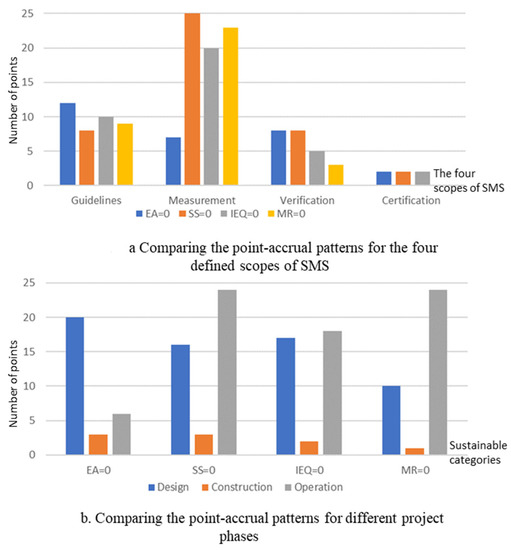
Figure 10.
The point accrual patterns for the four extreme simulation scenarios.
6. Discussion
The current methods for SMS lack a comprehensive perception to guide the certification process and ensure long-term performance [45,47]. Thus, the use of ST for SMS provides a deeper understanding of the complexity of the process and the several interrelated parameters therein. The rate and pattern of credit gaining and point accrual can be predicted and traced across different project phases, which is an added value to the corpus of knowledge.
The research method constituted a series of steps to cover the prescriptive and performance aspects associated with SMS [17]. The four proposed scopes of SMS considered the requirement for ongoing updates regarding market potentials and best practices as noted in other studies [8]. This defined the why, what, when, and how to carry a sustainable SMS for green-certified projects.
Noting that existing standards and guidelines do not offer quantitative data, the study referred to the LEED system’s point-scoring mechanism to offer guidance for green-certified projects. This was necessary to provide the quantitative data input needed for the model construction. However, it should be noted that GBRSs may not be comprehensive enough and are subject to regular developments and updates according to the latest scientific findings [11,16]. In this way, practitioners are encouraged to be fully aware while using them that they act as a tool, not a solution in and of themselves.
It was also noted that the interplay of points for the case scenarios varied for the four defined scopes and across different project phases. Therefore, the analysis can be used to draw a unique portfolio for each project that expresses its conditions. This showed that the model could similarly be developed using the point score weighting of other green rating systems as well, which supports the reliability, relevance, and reproducibility of the results obtained.
7. Conclusions
Material selection is a complex process with dynamic long-term consequences. Hence, this study used the ST approach to scrutinize the effect of SMS for green-certified buildings, in terms of the certification system, and the long-term building performance. Thus, a theoretical underpinning for the complexity of SMS was developed based on previous literature. It was used to draw a perceptive inspection for regulating and directing the knowledge and practice of SMS, including a rating mechanism constituting prescriptive guidelines and measurement methods. Other attributes were associated with the certification mechanism to comply with the required verification techniques and certification requirements. These represented the real estate market’s growing needs. Optimizing these four-tiered processes across different project phases was pinpointed as the basis for an insightful selection of sustainable materials. This finding was later used to construct SMS in light of the LEED system and helped define and categorize MR-dependent categories and credits and computed their DC. It was found that, by incorporating MR-dependent credits into a wider system model, they acquired a level of combinatorial complexity that necessitated a thorough examination of their internal structure. Hence, causal relations were pinpointed, and the MR category indicated the highest DC of 100%, followed by IEQ, EA, and SS of 68.8%, 57.6%, and 50%, respectively.
Causal relations helped construct an ST model which demonstrated the optimum case of gaining all points for extreme scenarios. These represented cases of failure to obtain points under the main sustainable categories, which affected the point-gaining patterns and changed the system’s behaviour and eventually the project’s certification level. The analysis examined the high leverage points of SMS to provide long-term benefits across different project phases.
Thus, the findings revealed that material selection should not be made in isolation but rather in conjunction with other sustainable criteria. This should consider the effect of the project site and location on material selection. Consequently, it should account for the effect of selected materials on the project’s energy performance and indoor environmental quality. When these causal relations were investigated, the optimal material selection could provide the project with 48 percent of the total potential points, qualifying it for the ‘Certified’ level. Extreme case scenarios were also scrutinized to indicate that projects can still earn points under other sustainable categories even if they failed to comply with the MR category. Nevertheless, the point accrual pattern changed for different scopes and across different project phases. This drew more attention to the ‘Guidelines’ scope in the case of EA = 0, when the point-accrual pattern characterized the design phase. More dependence on the ‘Measurement’ scope was demonstrated in the case of SS = 0, IEQ = 0, and MR = 0 when the point-accrual pattern characterized the stage of operation.
This study is intended to elucidate the role played by SMS in obtaining green building certification. Thus, scholars and practitioners will be able to think, act, and react to SMS using comprehensive approaches. The novelty of the proposed model is that it can act as a predictive tracing and evaluation mechanism for the rate and pattern of credit gaining and point accrual in green-certified projects. Incorporating the four-tiered model in the initial stages of a project enables a better understanding of the problem’s complexity. The suggested model can also be integrated with other project management tools to facilitate the allocation of time, money, and resources. This paves the way for further research concerning the green material industry and its intrinsic effects on building resilience.
Funding
This research received no external funding.
Data Availability Statement
All data can be made available upon request from the author.
Conflicts of Interest
The author declares no conflict of interest.
References
- Marzouk, M.; El-Hawary, M. Towards Evaluation and Prediction of Building Sustainability Using Life Cycle Behaviour Simulation. MATEC Web Conf. 2017, 120, 08002. [Google Scholar] [CrossRef]
- Thompson, B.P.; Bank, L.C. Use of System Dynamics as a Decision-Making Tool in Building Design and Operation. Build. Environ. 2010, 45, 1006–1015. [Google Scholar] [CrossRef]
- Ismaeel, W.S.E. Sustainable Site Selection Using System Dynamics; Case Study LEED-Certified Project. Archit. Eng. Des. Manag. 2021, 18, 368–386. [Google Scholar] [CrossRef]
- Ismaeel, W.S.E. Systems Thinking and Modelling for Buildings’ Sustainable Site Selection. In Proceedings of the 35th Annual ARCOM Conference, Leeds, UK, 2–4 September 2019; pp. 437–444. [Google Scholar]
- Bank, L.C.; McCarthy, M.; Thompson, B.P.; Menassa, C.C. Integrating BIM with System Dynamics as a Decision-Making Framework for Sustainable Building Design and Operation. In Proceedings of the First International Conference on Sustainable Urbanization (ICSU 2010), Hong Kong, China, 15–17 December 2010. [Google Scholar]
- Zou, Y.; Kiviniemi, A.; Jones, S.W. A Review of Risk Management through BIM and BIM-Related Technologies. Saf. Sci. 2017, 97, 88–98. [Google Scholar] [CrossRef]
- Elakkad, N.; Ismaeel, W.S.E. Coupling Performance-Prescriptive Based Daylighting Principles for Office Buildings: Case Study from Egypt. Ain Shams Eng. J. 2021, 12, 3263–3273. [Google Scholar] [CrossRef]
- Ismaeel, W.S.E. Drawing the Operating Mechanisms of Green Building Rating Systems. J. Clean. Prod. 2019, 213, 599–609. [Google Scholar] [CrossRef]
- Ismaeel, W.S.E.; Ali, A.A.M.M. Assessment of Eco-Rehabilitation Plans: Case Study ‘Richordi Berchet’ Palace. J. Clean. Prod. 2020, 259, 120857. [Google Scholar] [CrossRef]
- Ismaeel, W.S.E.; Elsayed, M.A. The Interplay of Environmental Assessment Methods; Characterising the Institutional Background in Egypt. J. Environ. Assess. Policy Manag. 2018, 20, 1850003. [Google Scholar] [CrossRef]
- Ismaeel, W.S.E. LEED in the MENA Regio …Chances and Challenges of Change. In Green Building in Developing Countries; Gou, Z., Ed.; Springer: Cham, Switzerland, 2020; pp. 237–252. ISBN 978-3-03024-650-1. [Google Scholar]
- Ismaeel, W.S.E.; Elsayed, M.A. Sustainable Sites in Two Generations of City Development Using GIS-MCDM and LEED LT and SS Categories. J. Clean. Prod. 2022, 330, 129782. [Google Scholar] [CrossRef]
- Chang, S.; Castro-Lacouture, D.; Yamagata, Y. Decision Support for Retrofitting Building Envelopes Using Multi-Objective Optimization under Uncertainties. J. Build. Eng. 2020, 32, 101413. [Google Scholar] [CrossRef]
- Anand, C.K.; Amor, B. Recent Developments, Future Challenges and New Research Directions in LCA of Buildings: A Critical Review. Renew. Sustain. Energy Rev. 2017, 67, 408–416. [Google Scholar] [CrossRef]
- Sterman, J.D.; John, D. Sterman System Dynamics: Systems Thinking and Modeling for a Complex World. Proc. ESD Intern. Symp. 2002, 147, 248–249. [Google Scholar] [CrossRef]
- Ismaeel, W.S.E. Appraising a Decade of LEED in the MENA Region. J. Clean. Prod. 2019, 213, 733–744. [Google Scholar] [CrossRef]
- Walaa, S.E. Ismaeel Material Selection for Sustainable Buildings. In Proceedings of the 37th Annual Conference for the Association of Researchers in Construction Management (ARCOM), Leeds, UK, 6–7 September 2021; pp. 784–793. [Google Scholar]
- Peris Mora, E. Life Cycle, Sustainability and the Transcendent Quality of Building Materials. Build. Environ. 2007, 42, 1329–1334. [Google Scholar] [CrossRef]
- Singh, T.; Page, D.; Simpson, I. Manufactured Structural Timber Building Materials and Their Durability. Constr. Build. Mater. 2019, 217, 84–92. [Google Scholar] [CrossRef]
- Hunag, L.J.; Wang, H.Y.; Wang, S.Y. A Study of the Durability of Recycled Green Building Materials in Lightweight Aggregate Concrete. Constr. Build. Mater. 2015, 96, 353–359. [Google Scholar] [CrossRef]
- Folke, C.; Carpenter, S.R.; Walker, B.; Scheffer, M.; Chapin, T.; Rockström, J. Resilience Thinking: Integrating Resilience, Adaptability and Transformability. Ecol. Soc. 2010, 15, 20. [Google Scholar] [CrossRef]
- Osma, G.; Amado, L.; Villamizar, R.; Ordoñez, G. Building Automation Systems as Tool to Improve the Resilience from Energy Behavior Approach. Procedia Eng. 2015, 118, 861–868. [Google Scholar] [CrossRef]
- Brambilla, G.; Lavagna, M.; Vasdravellis, G.; Castiglioni, C.A. Environmental Benefits Arising from Demountable Steel-Concrete Composite Floor Systems in Buildings. Resour. Conserv. Recycl. 2019, 141, 133–142. [Google Scholar] [CrossRef]
- Sun, J.; Bin, H.; Ekwaro-Osire, S.; Zhang, H.-C. Design for Environment: Methodologies, Tools, and Implementation. J. Integr. Des. Process Sci. 2003, 7, 59–75. [Google Scholar]
- He, Z.; Zhang, Y.; Wei, W. Formaldehyde and VOC Emissions at Different Manufacturing Stages of Wood-Based Panels. Build. Environ. 2012, 47, 197–204. [Google Scholar] [CrossRef]
- Scolaro, A.M.; De Medici, S. Downcycling and Upcycling in Rehabilitation and Adaptive Reuse of Pre-Existing Buildings: Re-Designing Technological Performances in an Environmental Perspective. Energies 2021, 14, 6863. [Google Scholar] [CrossRef]
- Moussa, R.R.; Ismaeel, W.S.E.; Solban, M.M. Energy Generation in Public Buildings Using Piezoelectric Flooring Tiles: A Case Study of a Metro Station. Sustain. Cities Soc. 2022, 77, 103555. [Google Scholar] [CrossRef]
- Mahmoud, S.; Ismaeel, W.S.E. Developing Sustainable Design Guidelines for Roof Design in a Hot Arid Climate. Archit. Sci. Rev. 2019, 62, 507–519. [Google Scholar] [CrossRef]
- Alvarez-Martin, A.; Kavich, G. SPME-GC–MS for the off-Gassing Analysis of a Complex Museum Object. Microchem. J. 2021, 167, 106276. [Google Scholar] [CrossRef]
- Bribián, I.Z.; Capilla, A.V.; Usón, A.A. Life Cycle Assessment of Building Materials: Comparative Analysis of Energy and Environmental Impacts and Evaluation of the Eco-Efficiency Improvement Potential. Build. Environ. 2011, 46, 1133–1140. [Google Scholar] [CrossRef]
- Entrop, A.G.; Brouwers, H.J.H. Assessing the Sustainability of Buildings Using a Framework of Triad Approaches. J. Build. Apprais. 2010, 5, 293–310. [Google Scholar] [CrossRef]
- Thormark, C. A Low Energy Building in a Life Cycle—Its Embodied Energy, Energy Need for Operation and Recycling Potential. Build. Environ. 2002, 37, 429–435. [Google Scholar] [CrossRef]
- Ismaeel, W.S.E.; Mohamed, A.G. A Structural Equation Modelling Paradigm for Eco-Rehabilitation and Adaptive Reuse of Cultural Heritage Buildings. Build. Environ. 2023, 242, 110604. [Google Scholar] [CrossRef]
- Ismaeel, W.S.E.; Alamoudy, F.O.; Sameh, R. How Renovation Activities May Jeopardize Indoor Air Quality: Accounting for Short and Long-Term Sick Building Syndromes in Educational Buildings. J. Archit. Eng. Des. Manag. 2022, 19, 360–377. [Google Scholar] [CrossRef]
- Ismaeel, W.S.E.; Mohamed, A.G. Indoor Air Quality for Sustainable Building Renovation: A Decision-Support Assessment System Using Structural Equation Modelling. Build. Environ. 2022, 214, 108933. [Google Scholar] [CrossRef]
- Ismaeel, W.S.E.; Kassim, N. An Environmental Management Plan for Construction Waste Management. Ain Shams Eng. J. 2023, 102244, in press. [Google Scholar] [CrossRef]
- Gauthier, M.; Simard, L.; Waaub, J.P. Public Participation in Strategic Environmental Assessment (SEA): Critical Review and the Quebec (Canada) Approach. Environ. Impact Assess. Rev. 2011, 31, 48–60. [Google Scholar] [CrossRef]
- Castro-Lacouture, D.; Sefair, J.A.; Flórez, L.; Medaglia, A.L. Optimization Model for the Selection of Materials Using a LEED-Based Green Building Rating System in Colombia. Build. Environ. 2009, 44, 1162–1170. [Google Scholar] [CrossRef]
- Giudice, F.; La Rosa, G.; Risitano, A. Materials Selection in the Life-Cycle Design Process: A Method to Integrate Mechanical and Environmental Performances in Optimal Choice. Mater. Des. 2005, 26, 9–20. [Google Scholar] [CrossRef]
- Sirisalee, P.; Ashby, M.F.; Parks, G.T.; Clarkson, P.J. Multi-Criteria Material Selection in Engineering Design. Adv. Eng. Mater. 2004, 6, 84–92. [Google Scholar] [CrossRef]
- Kumar, R.; Jagadish; Ray, A. Selection of Material for Optimal Design Using Multi-Criteria Decision Making. Procedia Mater. Sci. 2014, 6, 590–596. [Google Scholar] [CrossRef]
- Krarti, M.; Ihm, P. Evaluation of Net-Zero Energy Residential Buildings in the MENA Region. Sustain. Cities Soc. 2016, 22, 116–125. [Google Scholar] [CrossRef]
- Van Tran, V.; Park, D.; Lee, Y.C. Indoor Air Pollution, Related Human Diseases, and Recent Trends in the Control and Improvement of Indoor Air Quality. Int. J. Environ. Res. Public Health 2020, 17, 2927. [Google Scholar] [CrossRef]
- Ding, Z.; Yi, G.; Tam, V.W.Y.; Huang, T. A System Dynamics-Based Environmental Performance Simulation of Construction Waste Reduction Management in China. Waste Manag. 2016, 51, 130–141. [Google Scholar] [CrossRef]
- Morsi, D.M.A.; Ismaeel, W.S.E.; Ehab, A.; Othman, A.A.E. BIM-Based Life Cycle Assessment for Different Structural System Scenarios of a Residential Building. Ain Shams Eng. J. 2022, 13, 101802. [Google Scholar] [CrossRef]
- Ajayi, S.O.; Oyedele, L.O.; Ceranic, B.; Gallanagh, M.; Kadiri, K.O. Life Cycle Environmental Performance of Material Specification: A BIM-Enhanced Comparative Assessment. Int. J. Sustain. Build. Technol. Urban Dev. 2015, 6, 14–24. [Google Scholar] [CrossRef]
- Morsi, D.M.A.; Ismaeel, W.S.E.; El Hamed, A.E.A.; Othman, A.A.E. Applying LCA-BIM Integration for a Sustainable Management Process. In Proceedings of the 36th Annual ARCOM Conference, Leeds, UK, 7–8 September 2020; pp. 416–424. [Google Scholar]
- Morsi, D.M.A.; Ismaeel, W.S.E.; El-Hamed, A.E.A. Life Cycle Assessment of a Residential Building in Egypt: A Case Study. IOP Conf. Ser. Mater. Sci. Eng. 2020, 974, 7–9. [Google Scholar] [CrossRef]
- Ismaeel, W.S.E.; Mohamed, F.; Elakkad, N. Scenarios of Occupational Capacity for High Educational Buildings in the Time of Covid. In Proceedings of the 37th Annual Conference for the Association of Researchers in Construction Management (ARCOM), Leeds, UK, 6–7 September 2021; pp. 644–653. [Google Scholar]
- Ismaeel, W.S.E. An Integrated Model for Energy-Efficient Building Practices. In Proceedings of the 9th International Conference on Software and Information Engineering (ICSIE 2020), Cairo, Egypt, 11–13 November 2020; pp. 204–208. [Google Scholar] [CrossRef]
- Eweda, A.; Al-Sakkaf, A.; Zayed, T.; Alkass, S. Condition Assessment Model of Building Indoor Environment: A Case Study on Educational Buildings. Int. J. Build. Pathol. Adapt. 2021, 41, 767–788. [Google Scholar] [CrossRef]
- Ismaeel, W.S.E.; Lotfy, R.A.E.R. An Integrated Building Information Modelling-Based Environmental Impact Assessment Framework. Clean Technol. Environ. Policy 2022, 25, 1291–1307. [Google Scholar] [CrossRef]
- Llatas, C.; Osmani, M. Development and Validation of a Building Design Waste Reduction Model. Waste Manag. 2016, 56, 318–336. [Google Scholar] [CrossRef]
- Yuan, H.; Chini, A.R.; Lu, Y.; Shen, L. A Dynamic Model for Assessing the Effects of Management Strategies on the Reduction of Construction and Demolition Waste. Waste Manag. 2012, 32, 521–531. [Google Scholar] [CrossRef]
- Hao, J.; Yuan, H.; Liu, J.; Chin, C.S.; Lu, W. A Model for Assessing the Economic Performance of Construction Waste Reduction. J. Clean. Prod. 2019, 232, 427–440. [Google Scholar] [CrossRef]
- Cole, R.J.; Jose Valdebenito, M. The Importation of Building Environmental Certification Systems: International Usages of BREEAM and LEED. Build. Res. Inf. 2013, 41, 662–676. [Google Scholar] [CrossRef]
- Chkanikova, O.; Kogg, B. Sustainability Governance Service Providers: The Role of Third-Party Product Certification in Facilitating Corporate Life Cycle Management. Int. J. Life Cycle Assess. 2018, 23, 1383–1395. [Google Scholar] [CrossRef]
- Merger, E.; Dutschke, M.; Verchot, L. Options for REDD+ Voluntary Certification to Ensure Net GHG Benefits, Poverty Alleviation, Sustainable Management of Forests and Biodiversity Conservation. Forests 2011, 2, 550–577. [Google Scholar] [CrossRef]
- Kraxner, F.; Schepaschenko, D.; Fuss, S.; Lunnan, A.; Kindermann, G.; Aoki, K.; Dürauer, M.; Shvidenko, A.; See, L. Mapping Certified Forests for Sustainable Management—A Global Tool for Information Improvement through Participatory and Collaborative Mapping. For. Policy Econ. 2017, 83, 10–18. [Google Scholar] [CrossRef]
- CEN CEN/TC 350—European Committee for Standardization—Technical Commitee 350. Available online: http://portailgroupe.afnor.fr/public_espacenormalisation/CENTC350/index.html (accessed on 13 June 2023).
- Minkov, N.; Lehmann, A.; Winter, L.; Finkbeiner, M. Characterization of Environmental Labels beyond the Criteria of ISO 14020 Series. Int. J. Life Cycle Assess. 2020, 25, 840–855. [Google Scholar] [CrossRef]
Disclaimer/Publisher’s Note: The statements, opinions and data contained in all publications are solely those of the individual author(s) and contributor(s) and not of MDPI and/or the editor(s). MDPI and/or the editor(s) disclaim responsibility for any injury to people or property resulting from any ideas, methods, instructions or products referred to in the content. |
© 2023 by the author. Licensee MDPI, Basel, Switzerland. This article is an open access article distributed under the terms and conditions of the Creative Commons Attribution (CC BY) license (https://creativecommons.org/licenses/by/4.0/).